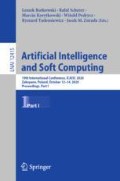Abstract
The paper proposes a method for the drone to catch the given target and avoid detected obstacles in its path based on the self-organizing migrating algorithm. In particular, a two-component fitness function is proposed based on the principle that the closer the target, the lower the fitness value, and the closer the obstacle, the higher the fitness value. Self-organizing migrating algorithm, a swarm intelligence algorithm, is used to predict the next positions that the drone will move to. These positions both satisfy the requirement to avoid obstacles and shorten the distance to the target. A map of two drones, two corresponding targets and four static obstacles was modeled on Matlab. The simulation results verify the correctness and effectiveness of the proposed method.
Access this chapter
Tax calculation will be finalised at checkout
Purchases are for personal use only
References
Arantes, M.S., Arantes, J.S., Toledo, C.F.M., Williams, B.C.: A hybrid multi-population genetic algorithm for UAV path planning. In: Proceedings of the Genetic and Evolutionary Computation Conference 2016, pp. 853–860 (2016)
Cabreira, T.M., Ferreira, P.R., Di Franco, C., Buttazzo, G.C.: Grid-based coverage path planning with minimum energy over irregular-shaped areas with UAVs. In: 2019 International Conference on Unmanned Aircraft Systems (ICUAS), pp. 758–767. IEEE (2019)
Del Ser, J., et al.: Bio-inspired computation: where we stand and what’s next. Swarm Evol. Comput. 48, 220–250 (2019)
Diep, Q.B., Zelinka, I.: The movement of swarm robots in an unknown complex environment. In: Zelinka, I., Brandstetter, P., Trong Dao, T., Hoang Duy, V., Kim, S.B. (eds.) AETA 2018. LNEE, vol. 554, pp. 949–959. Springer, Cham (2020). https://doi.org/10.1007/978-3-030-14907-9_92
Evenson, R., Ranis, G.: Science and Technology: Lessons for Development Policy. Routledge (2019)
Ghamry, K.A., Kamel, M.A., Zhang, Y.: Multiple UAVs in forest fire fighting mission using particle swarm optimization. In: 2017 International Conference on Unmanned Aircraft Systems (ICUAS), pp. 1404–1409. IEEE (2017)
Haenlein, M., Kaplan, A.: A brief history of artificial intelligence: on the past, present, and future of artificial intelligence. Calif. Manag. Rev. 61(4), 5–14 (2019)
Lin, Y., Saripalli, S.: Sampling-based path planning for UAV collision avoidance. IEEE Trans. Intell. Transp. Syst. 18(11), 3179–3192 (2017)
Mavrovouniotis, M., Li, C., Yang, S.: A survey of swarm intelligence for dynamic optimization: algorithms and applications. Swarm Evol. Comput. 33, 1–17 (2017)
Pan, T.-S., Dao, T.-K., Pan, J.-S., Nguyen, T.-T.: An unmanned aerial vehicle optimal route planning based on compact artificial bee colony. Advances in Intelligent Information Hiding and Multimedia Signal Processing. SIST, vol. 64, pp. 361–369. Springer, Cham (2017). https://doi.org/10.1007/978-3-319-50212-0_43
Phung, M.D., Quach, C.H., Dinh, T.H., Ha, Q.: Enhanced discrete particle swarm optimization path planning for UAV vision-based surface inspection. Autom. Constr. 81, 25–33 (2017)
Revay, L., Zelinka, I.: Swarm intelligence in virtual environment. J. Adv. Eng. Comput. 3(2), 415–424 (2019)
Roberge, V., Tarbouchi, M., Labonté, G.: Fast genetic algorithm path planner for fixed-wing military UAV using GPU. IEEE Trans. Aerosp. Electron. Syst. 54(5), 2105–2117 (2018)
Tian, G., Zhang, L., Bai, X., Wang, B.: Real-time dynamic track planning of multi-UAV formation based on improved artificial bee colony algorithm. In: 2018 37th Chinese Control Conference (CCC), pp. 10055–10060. IEEE (2018)
Truong, T.C., Zelinka, I., Senkerik, R.: Neural swarm virus. In: Zamuda, A., Das, S., Suganthan, P.N., Panigrahi, B.K. (eds.) SEMCCO/FANCCO - 2019. CCIS, vol. 1092, pp. 122–134. Springer, Cham (2020). https://doi.org/10.1007/978-3-030-37838-7_12
Wanka, R.: Swarm intelligence. IT Inf. Technol. 61(4), 157–158 (2019)
Yao, P., Wang, H., Su, Z.: Cooperative path planning with applications to target tracking and obstacle avoidance for multi-UAVs. Aerosp. Sci. Technol. 54, 10–22 (2016)
Zelinka, I.: SOMA—self-organizing migrating algorithm. In: New Optimization Techniques in Engineering, pp. 167–217. Springer, Heidelberg (2004). https://doi.org/10.1007/978-3-540-39930-8_7
Zelinka, I.: SOMA—self-organizing migrating algorithm. In: Davendra, D., Zelinka, I. (eds.) Self-Organizing Migrating Algorithm. SCI, vol. 626, pp. 3–49. Springer, Cham (2016). https://doi.org/10.1007/978-3-319-28161-2_1
Zelinka, I., Das, S., Sikora, L., Šenkeřík, R.: Swarm virus-next-generation virus and antivirus paradigm? Swarm Evol. Comput. 43, 207–224 (2018)
Zelinka, I., Sikora, L.: StarCraft: brood war—strategy powered by the soma swarm algorithm. In: 2015 IEEE Conference on Computational Intelligence and Games (CIG), pp. 511–516. IEEE (2015)
Acknowledgment
The following grants are acknowledged for the financial support provided for this research: Grant of SGS No. SP2020/78, VSB-Technical University of Ostrava.
Author information
Authors and Affiliations
Corresponding author
Editor information
Editors and Affiliations
Rights and permissions
Copyright information
© 2020 Springer Nature Switzerland AG
About this paper
Cite this paper
Diep, Q.B., Truong, T.C., Zelinka, I. (2020). Obstacle Avoidance for Drones Based on the Self-Organizing Migrating Algorithm. In: Rutkowski, L., Scherer, R., Korytkowski, M., Pedrycz, W., Tadeusiewicz, R., Zurada, J.M. (eds) Artificial Intelligence and Soft Computing. ICAISC 2020. Lecture Notes in Computer Science(), vol 12415. Springer, Cham. https://doi.org/10.1007/978-3-030-61401-0_35
Download citation
DOI: https://doi.org/10.1007/978-3-030-61401-0_35
Published:
Publisher Name: Springer, Cham
Print ISBN: 978-3-030-61400-3
Online ISBN: 978-3-030-61401-0
eBook Packages: Computer ScienceComputer Science (R0)

